Every gardener knows there is simply no comparison between fresh, homegrown, vine-ripened tomatoes and the off-season, bland, oddly textured things designed to be tossed around in transit that are sold in grocery stores.

A gardener will—literally—wait all year for their new crop of tomatoes to come in. Which makes it all the harder to wait for your fresh tomatoes to go from green to red on the vine—something that seems to take forever when you’re watching. Much like the proverbial kettle that won’t boil under your watchful gaze, it seems like tomatoes won’t ripen, either.
If only there was something you could do to make those lovely globes of red deliciousness ripen faster. But wait! There is! Several things, as a matter of fact.
Jump to:
- How to Speed Up Tomato Ripening on the Vine
- Increase Airflow
- Water Properly
- Reduce Watering to Induce Managed Plant Stress
- Help Tomatoes Stay Cool in Hot Weather
- Help Them Stay Warm in Cool Weather
- Top it Off
- Prune the Roots
- Lighten the Load
- When You Just Can’t Wait...
- Tips for Speedy Ripening off the Vine
- Maximizing the Tomato Harvest by Speeding Ripening
How to Speed Up Tomato Ripening on the Vine

There are several ways to convince your tomatoes to start ripening. Which method—or methods—you choose will depend on the time of year and what is the most likely reason that your tomatoes are not yet ripening.
Here are some of the best methods for ripening garden tomatoes, along with tips for when to use each one:
Increase Airflow
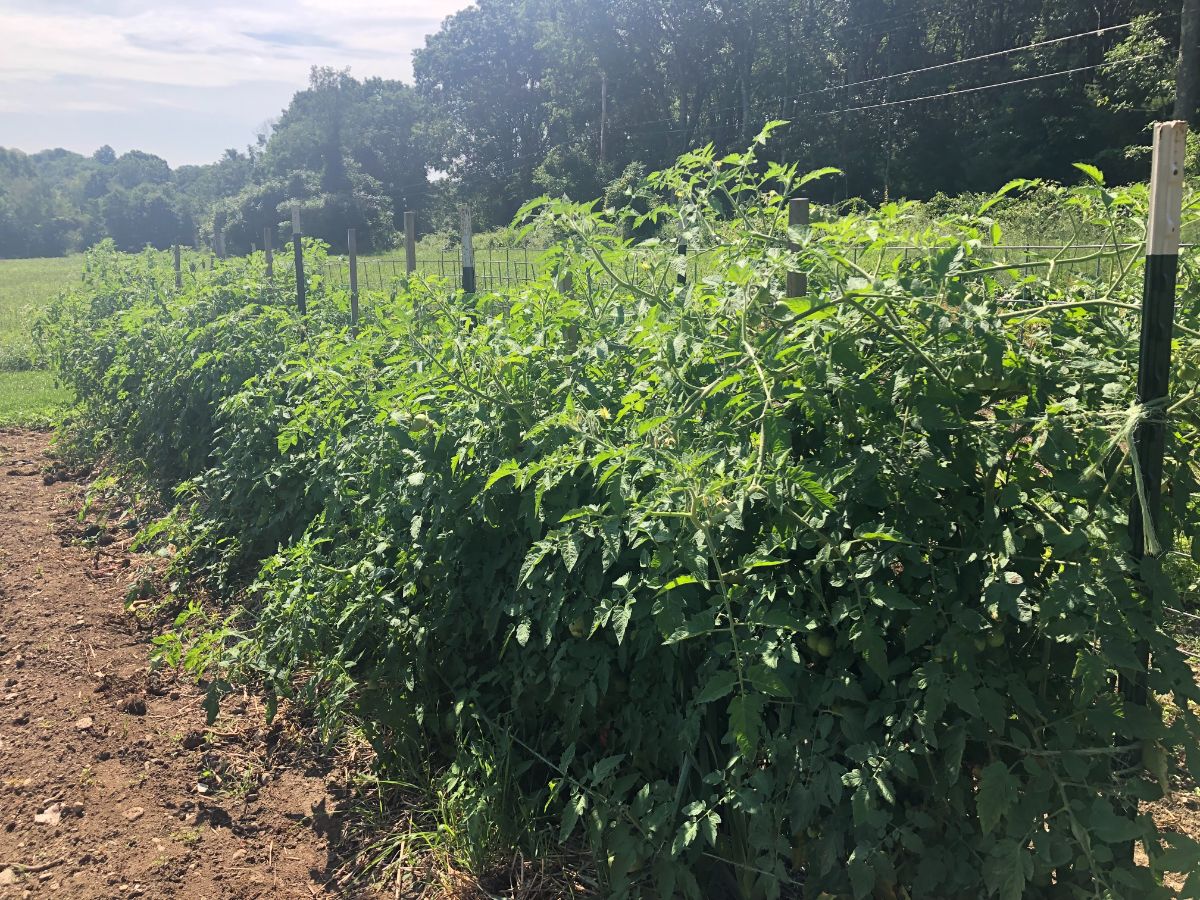
We talk about airflow a lot when we talk about tomato health. Good air circulation is one of the best ways to prevent tomato blight and other common fungal diseases. You might not realize it, but increasing the air circulation through your tomato plant also helps to support the ripening process. It can speed it up, too.
How can you do this? First off, start with smart spacing when you plant your tomato plants. Follow space recommendations for the varieties you grow. A good rule of thumb is at least two feet between each plant. Up to three feet can give your tomatoes even more room to breathe.
Secondly, create airflow by pruning off some of the lower leaves and branches. This will help create drafting to circulate air up through the plant. For smaller plants (like shorter determinate varieties), remove the foliage up to about 8 or 10 inches. For larger, indeterminate varieties, remove the bottom 12 inches of foliage, up to as much as 18 inches.
If your foliage is thick, you can also remove some of the extra leaves, but you will want to take care not to remove so many leaves that you are exposing the tomatoes to sunburn or that you are cutting off fruit-producing blossoms. (About 25% of foliage is the right total, including low leaves. Leave more top leaves than bottom leaves to shade the fruit, reduce temperatures on the fruit, and prevent sun scalding.)
Water Properly
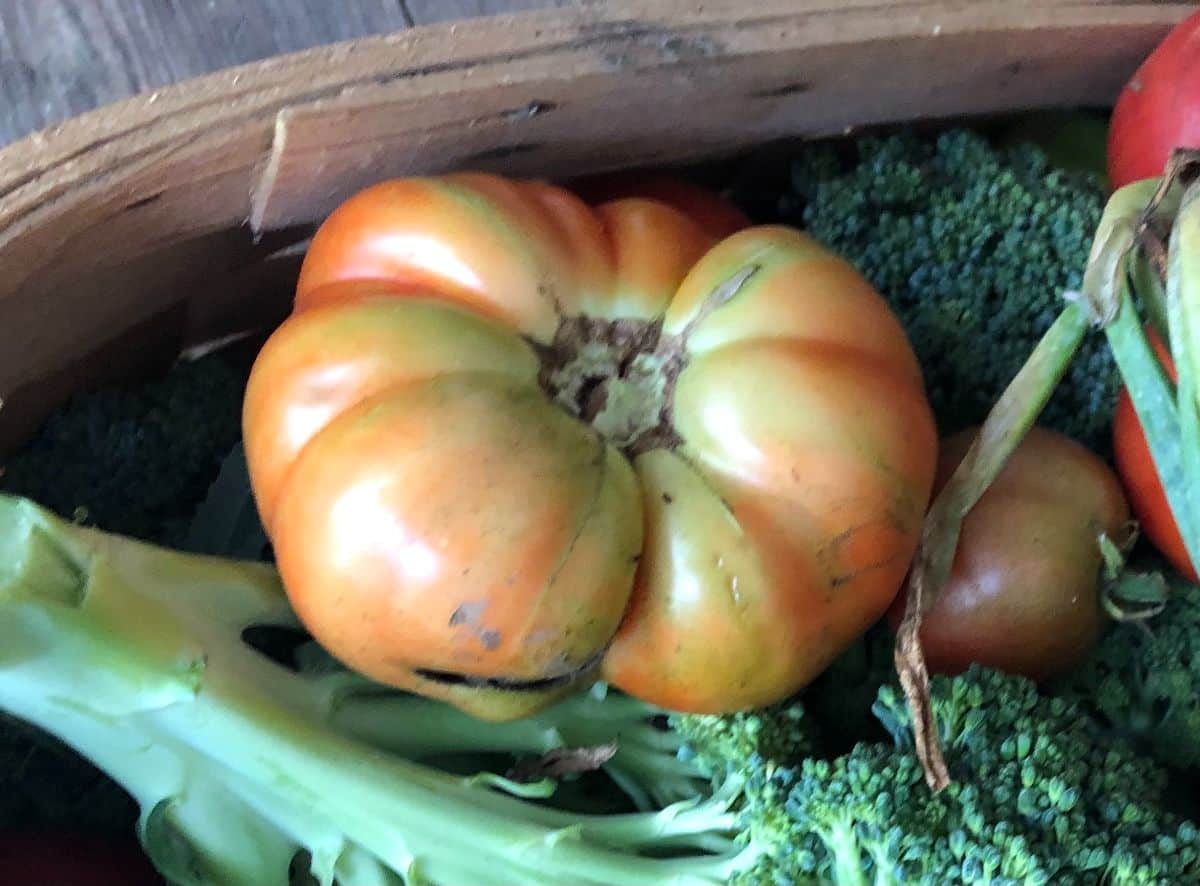
Too much water and inconsistent watering can cause problems for tomatoes. Cracking is one of the most common signs of overwatering and inconsistent watering. Slow ripening may be another.
When tomatoes get too much water, they tend to stop growth and production until the situation is corrected. Ripening is a part of growth and production, so the plant will stop that, too. If you have to water, you only need to give your tomato plants about one inch of water total (natural rainwater plus supplemental irrigation) per week.
If you’re not sure how much water your tomato patch is getting, place a rain gauge at the end of a row, or sink an empty tuna or cat food can (which is about one inch deep) into the ground at the end of the row.
If the can is not full at the end of the week, your tomatoes need more water. If it fills up and overflows, they’re getting too much water. If you’re using drip lines or soaker hoses for watering (a far better choice than overhead sprinklers), make sure the line can drip into the can so you get an accurate measure.
Reduce Watering to Induce Managed Plant Stress
While too much water can tell tomatoes to stop what they’re doing, the managed withholding of water can do the opposite. Plants know that, like us, without water, they will die. The one thing plants live to do is to reproduce—to set fruit and seed that will fall and begin the cycle of reproduction and life again.
When plants think their death might be eminent, they tend to act in ways to speed up the perpetuation of their species. For tomatoes, that means quickly maturing their fruit to ripening so the seeds become viable and able to grow. This may even improve the flavor of your tomatoes.
You do not want to just stop watering your tomatoes altogether, though. You want to gradually induce a state that is stressful and threatening to the plant but that will not kill it off completely. Reduce the amount of water you give the plants over two or three weeks.
As mentioned above, this would be the total amount of water they get, including rain, to whatever extent you can control that. It may be that you will reduce or eliminate the supplemental water you give your tomatoes and let them only have what comes naturally.
Help Tomatoes Stay Cool in Hot Weather
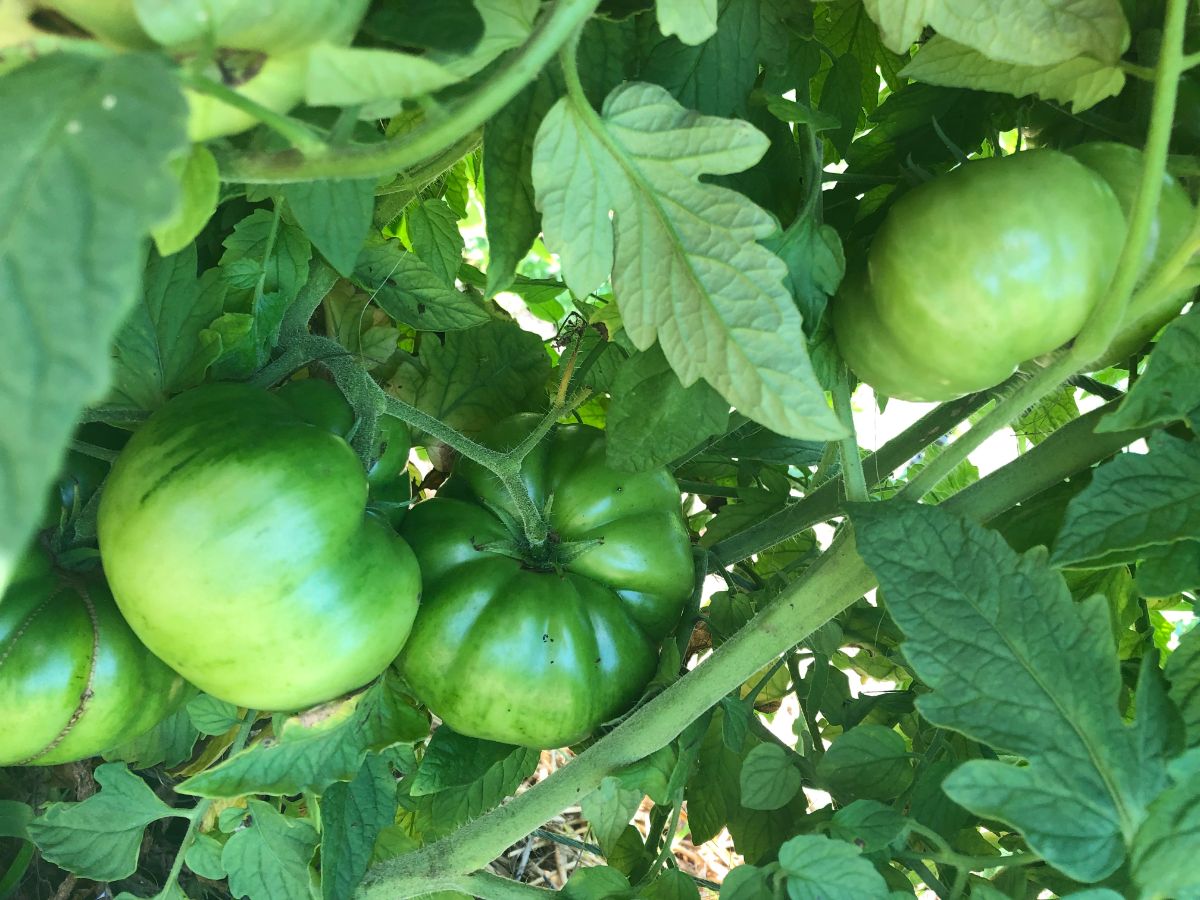
The ideal temperature for ripening tomatoes is in the low to mid 70’s (70 to 75 degrees Fahrenheit (F) or around 23 degrees Celsius (C)). As the temperature increases, the ripening process slows down. If it is too hot for too long, the tomatoes won’t ripen during that time, and ripening may stop completely in very high temperatures until the temps moderate again.
You can’t control the weather, of course. You can take some steps to keep your plants cooler. You can create shade by stretching a tarp on stakes or cut saplings above your tomato patch. Or you can use a floating row cover during the hottest parts of the day.
If you anticipate the problem when you plant, you can select your planting location accordingly. Your tomatoes will need full sun for six to eight hours of the day to grow, develop, and mature. If your garden gets more than this, plant your tomatoes where they can get some shade in the hotter parts of the day to help reduce the temperature of the plants.
If you don’t have shade, planting something tall that will cast shade, like sunflowers, is an option. (But again, make sure the tomatoes are not entirely shaded all day—position tall plants so they cast a shadow on the tomato patch when you want the shade.)
Though the plants need full sunlight to grow and produce properly, they don’t use much sunlight to ripen the fruit. In fact, too much sun will do just the opposite—make the plant too hot so that it shuts down, producing and ripening, and cause sun scald and burns that can basically scar the fruit and cause patchy, discolored ripening and rot.
Of course, even with these measures, there is only so much help you can give if it is very hot. In that case, you can wait it out until cooler weather prevails, or you can remove some of the more mature fruit and bring it inside to ripen (see below). Once the tomatoes are inside in temperatures in the 70s, they should start to ripen (as long as they are mature enough to do so).
Help Them Stay Warm in Cool Weather
In the fall, as days grow cooler, the opposite may be a problem. If temperatures are staying consistently below 70F (about 22C), your plants may not be warm enough for tomatoes to ripen. In this case, do what you can to warm them up.
Floating row covers are one option. It is helpful to put them on at night to hold warmth in for longer and keep the plants and fruit warmer. Use them when spotty frosts threaten, and you may get your plants through the first light frost or two.
If temperatures are just not getting warm enough during the day, or frost is becoming a real threat, it is time to remove the unripe green and blushing tomatoes and ripen them inside, where they will be protected.
Top it Off
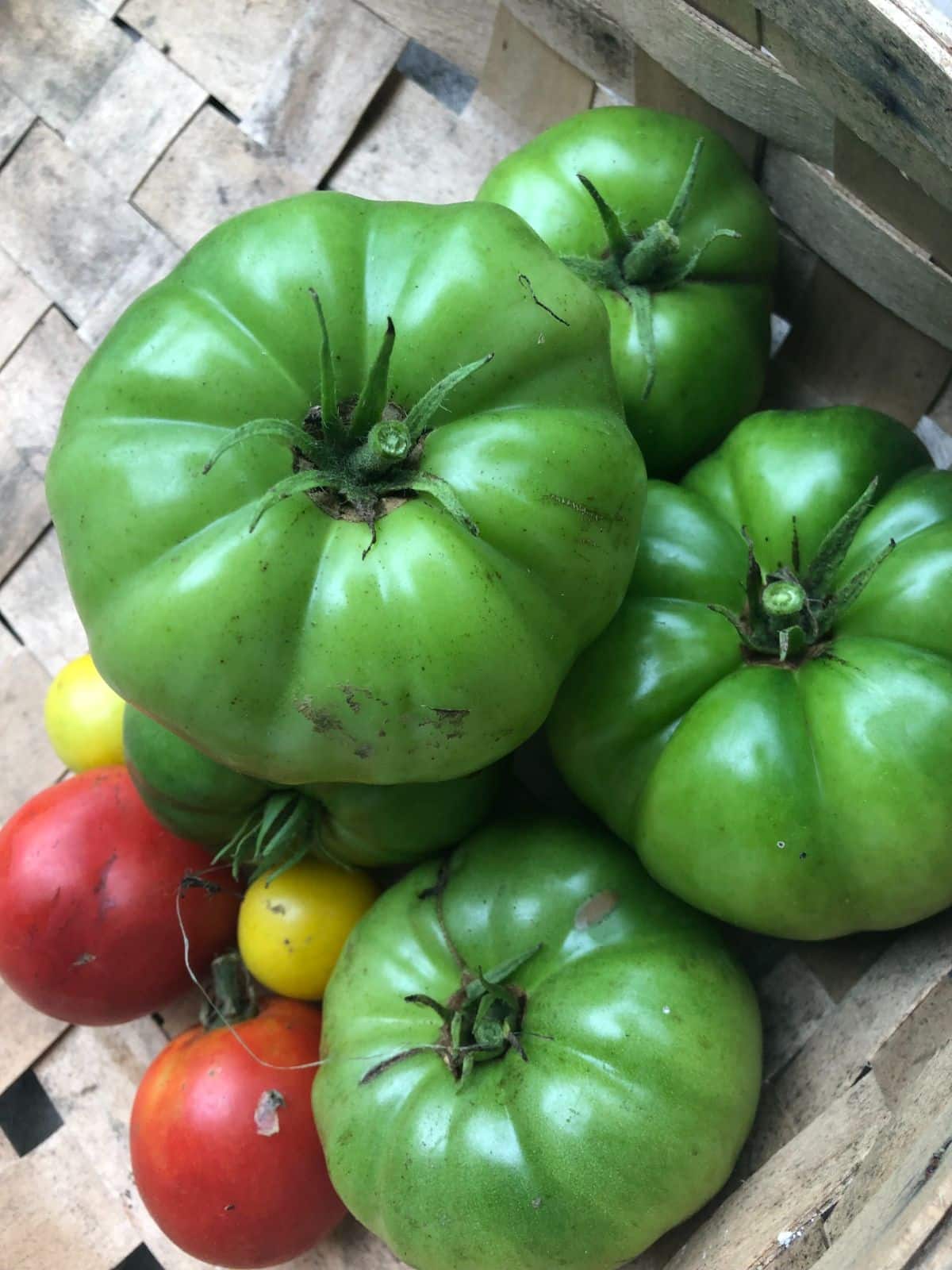
This is something that is most often done later in the season when the idea of frost and the season’s end is starting to become a reality. But it is something you can do at any time in the season if you’ve decided you have enough maturing fruit on the vine.
Prune or trim the top growth tips. These will be the tips of the main stem or stems (depending on your pruning methods). You would normally only cut back to just above the top-most set of blossoms.
This method is usually done only on indeterminate tomato plants and isn’t very likely to help determinate varieties very much since their fruit set is predetermined, and they aren’t actively trying to grow and produce blossoms after most of the fruit is set.
Prune the Roots
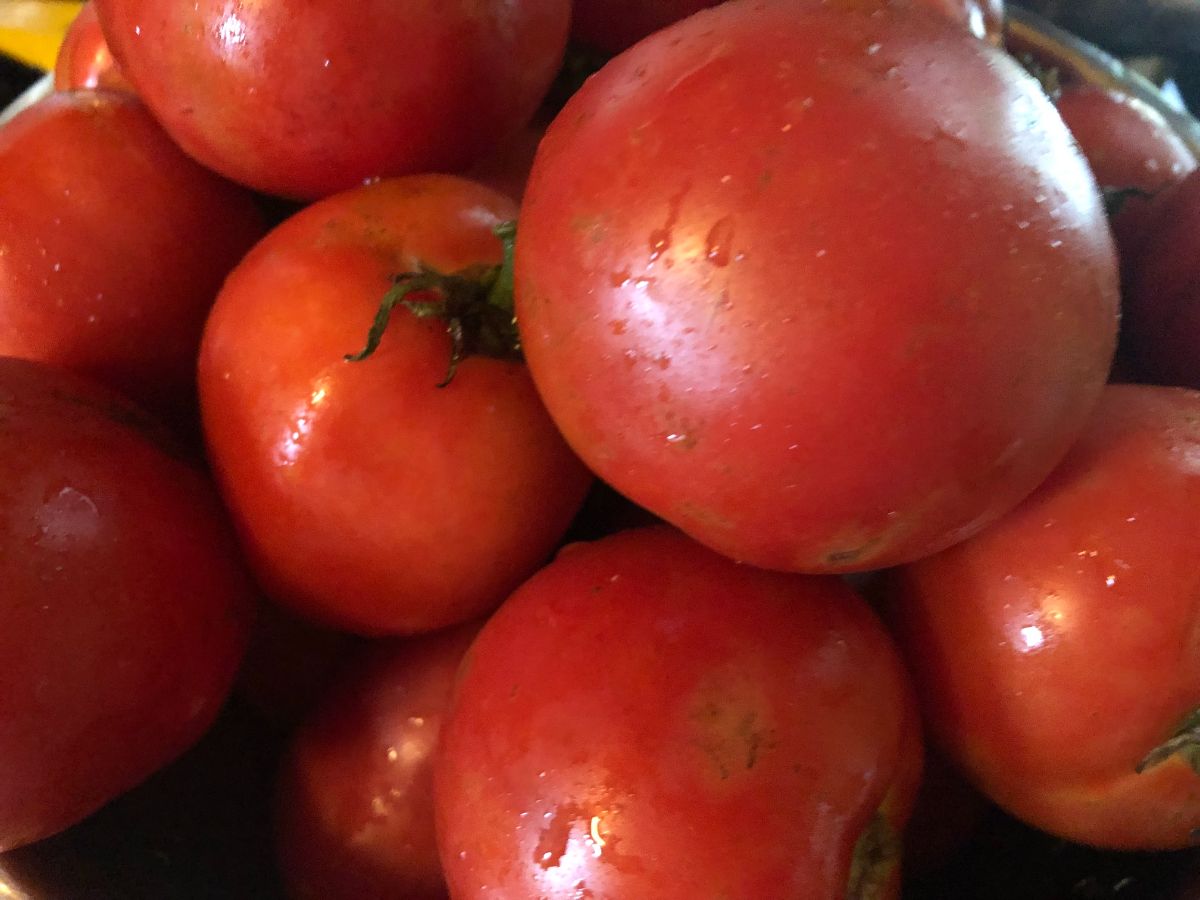
Root pruning is another way to send the tomato plant into a state of stress and survival. It works similarly to how withholding water and topping the plant works. The stressed plant will send its energy into survival mode and maturing and ripening the fruit.
Pruning roots is a bit riskier, but it’s common enough and simple enough. If you’re on the fence about it, consider pruning just one or two plants to start the waterfall of ripening fruit.
It’s best to let the plant set at least the first clusters of tomatoes and for them to get close to a mature stage, ready to start ripening. Here’s a quick primer on how to prune tomato roots:
- Use a knife or a pointed spade shovel
- Move out about one foot from the base of the tomato plant
- Cut straight down to sever and shorten the root system
- Sink your knife or shovel about eight to ten inches down so you hit the main roots, which by this point in the season should be about eight or ten inches deep
- Move around the plant, cutting the roots in a “C” halfway around the plant
As with withholding water, this method is said to both speed ripening and to improve the flavor of the tomatoes.
Lighten the Load
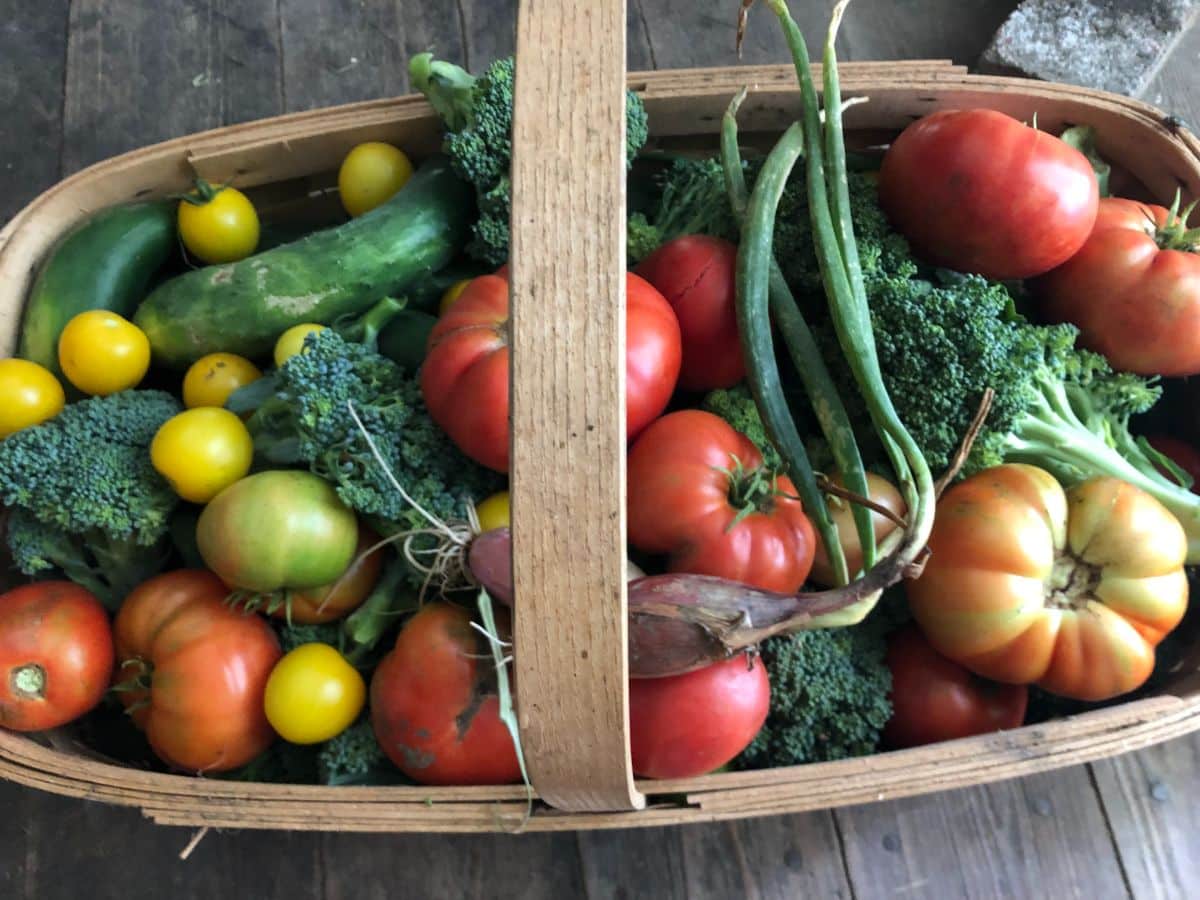
Keep your plant picked of ripe fruit. When you remove fruit from the plant, it lets that plant put more energy into the fruit that is still growing and struggling to ripen. With fewer fruits to support, the plant can redirect its energy to where it's needed. In fact, it’s a good idea to take some of the more mature and underripe tomatoes off to ripen off the vine to free up the plants’ energy and resources anyway.
If it’s getting late in the season and you’re starting to near your first frost date, it’s smart to take the small, young, immature tomatoes off (the ones that are not likely to grow large enough or mature enough to ripen before frost kills the plant). That will let your tomatoes stop putting energy into fruit that will never grow mature enough to ripen on or off the vine.
When You Just Can’t Wait...
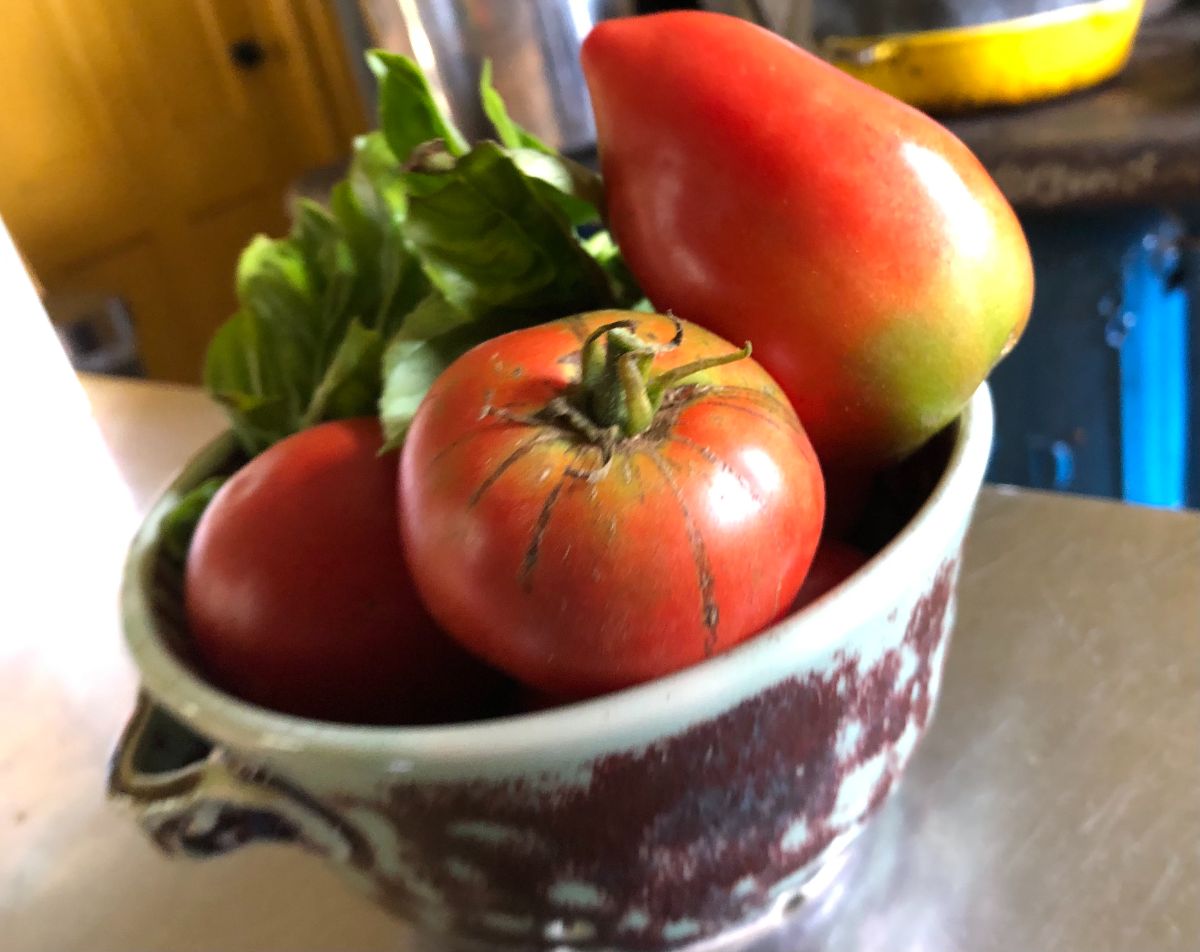
When you can’t wait for fresh ripe tomatoes, or, as mentioned above, you want to give your plants a boost to send energy into other developing blossoms and fruit, go ahead and take some tomatoes off the vine to ripen. Tomatoes will usually ripen faster off the vine than on it. There is a trick to successfully ripening tomatoes off the vine, though. They must have already started the ripening process—been told by the plant to ripen, basically.
To ripen green tomatoes, you need to pick them after they have matured enough. Green doesn’t automatically mean ready to ripen. Tomatoes that aren’t quite ready to ripen on or off the vine will be a dull, matte color, while tomatoes that are ready to ripen are shiny green. Their skins will reflect light when it shines on them.
Another way to tell if tomatoes are getting ready to start ripening is to gently squeeze them. Tomatoes that have started the early ripening process will be slightly soft and have some give. Tomatoes that are not ready will be hard and will have very little give.
If there’s no rush to ripen and there’s not a reason why your tomatoes have to come off the bush (other than your eagerness to start eating them), wait until they start to blush a little. When you start to see light pinking up or redness, you know for sure the fruit is ready to ripen. Now you can take it off and speed up the process inside and let the plant start putting its energy into the remaining fruit and blossoms.
Tips for Speedy Ripening off the Vine
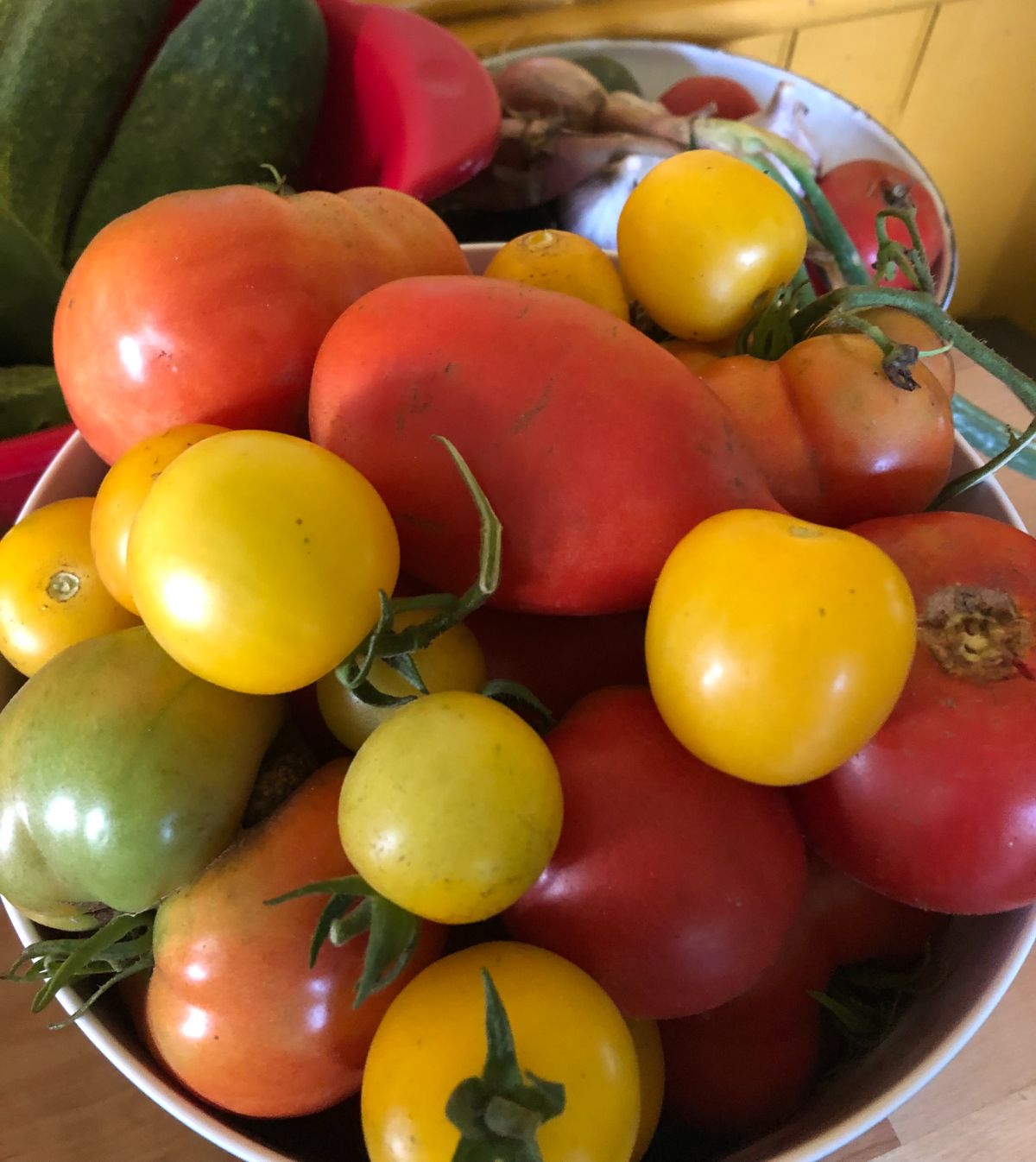
Off the vine, there is a range of time that it can take for tomatoes to ripen. This mostly depends on the tomato variety and on how mature the fruit was when you picked it (those blushing red tomatoes will ripen much quicker than the shiny greens that weren't started much).
Tomatoes should not be refrigerated after they are picked. Leave them on the counter but out of direct sunlight, and they will ripen. Refrigerating will stop ripening, and it will probably not start again. To help unripe tomatoes ripen off the vine so you can eat them quicker,
- Place the tomatoes in a paper bag. Fold the top over.
- Don't overstuff the bag—leave some space for air circulation. This will help circulate the ethylene gas that they produce while ripening, too, which will help the other tomatoes in the bag ripen.
- To really speed things up, put a piece of fruit in the bag that will give off ethylene gas. Apples and bananas are good choices (bananas are the best). You’ll only need one piece of fruit per paper bag.
Maximizing the Tomato Harvest by Speeding Ripening
It’s hard to wait for homegrown tomatoes to ripen. Though the season can last a couple of months, it’s always too short, especially for growers in the north and in the hot south. It’s smart to do what you can to speed up the ripening of the season’s early fruit so that you can enjoy the harvest for as long as you possibly can.
Use these tips to jump-start your tomato ripening and stretch that happiest time of the year to as early—and as late—as possible.

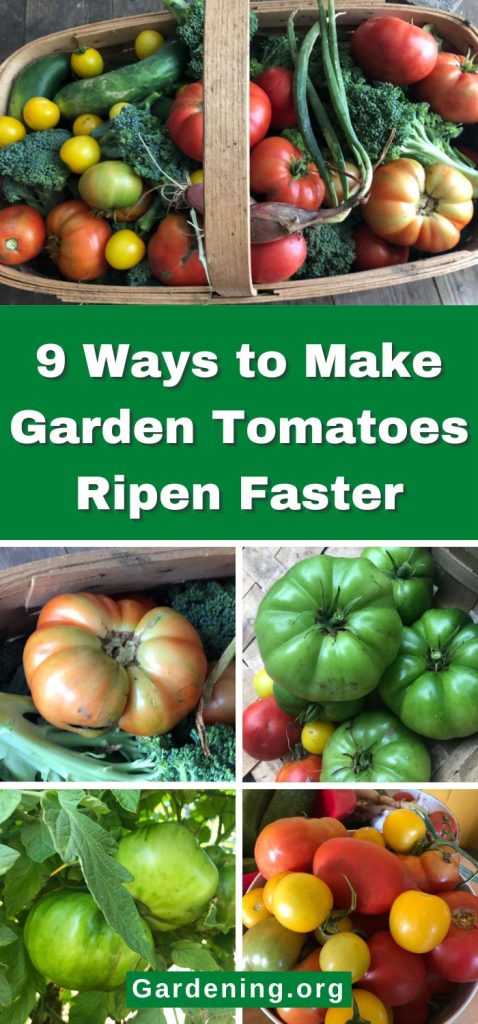
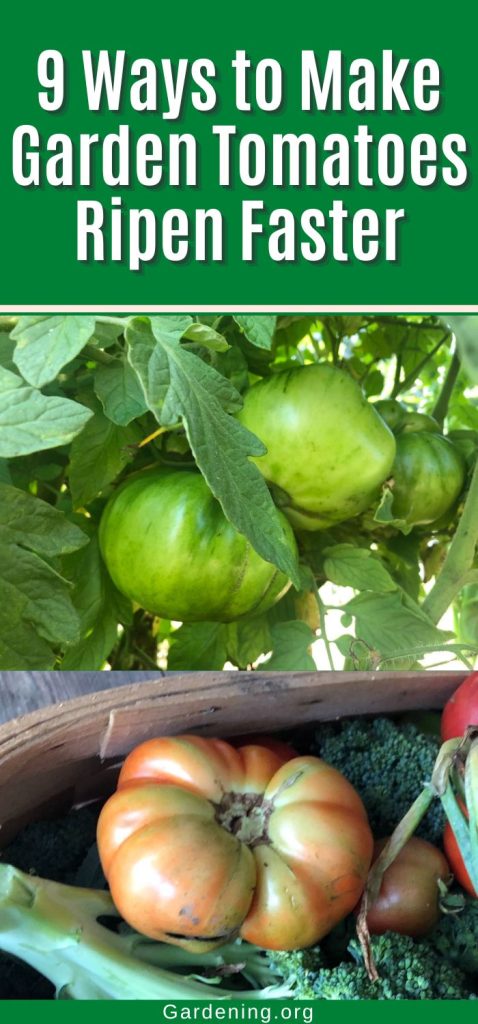
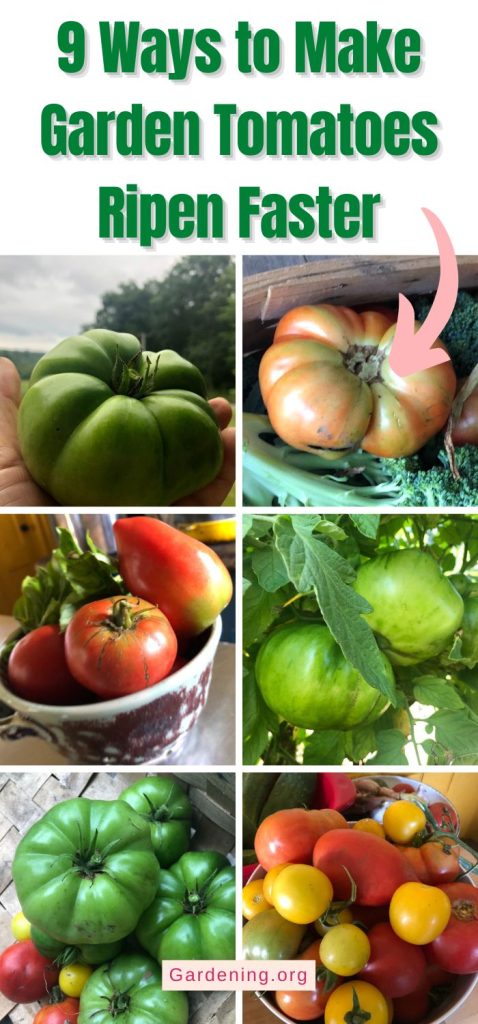
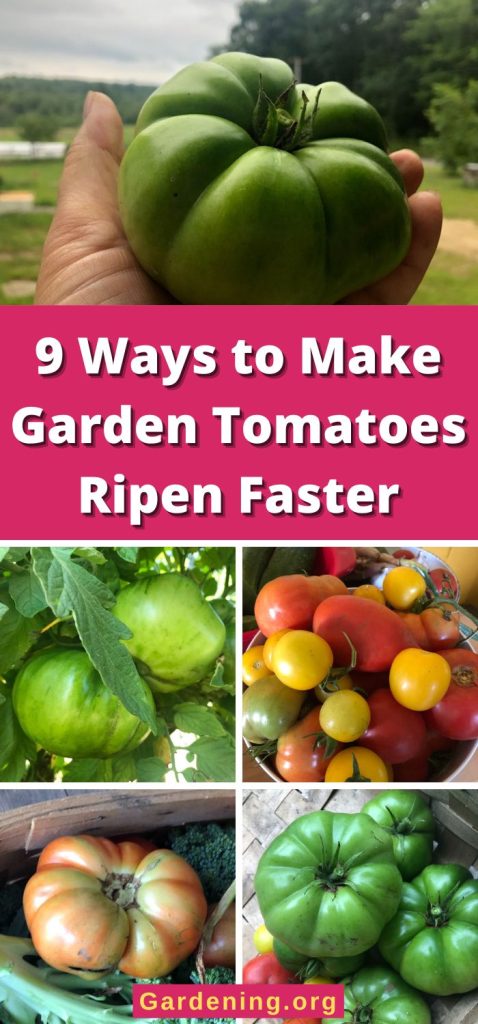

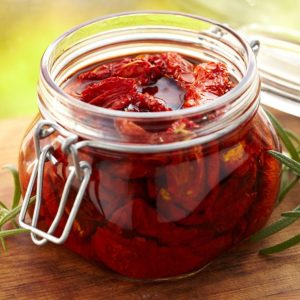
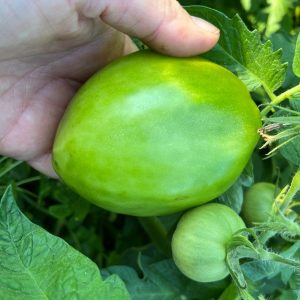

Leave a Reply